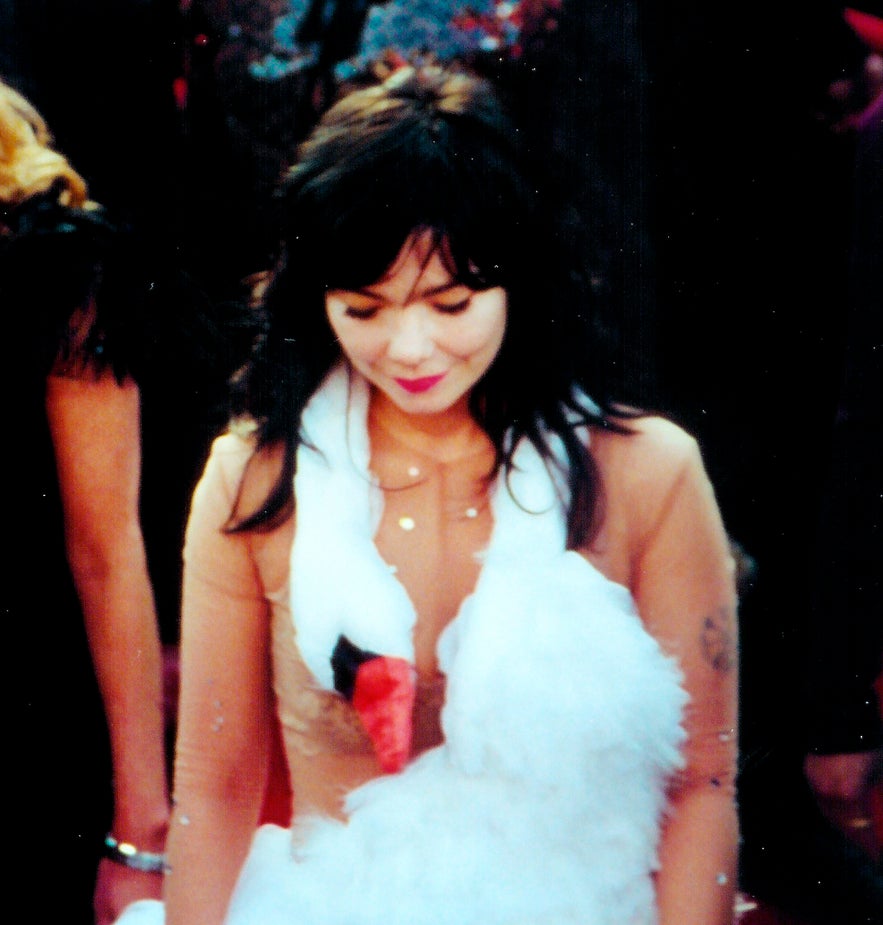뮤지션 뷔욕 구드문드스도티르(Björk Guðmundsdóttir) 혹은 비요크는 아이슬란드에서 가장 유명하고 독창적이자 영향력 있는 예술가입니다. 그의 음악 스타일은 전자음에서 얼터너티브, 재즈, 일렉트로닉, 아방가르드, 클래식을 넘나들죠. 뷔욕은 독특한 사운드와 경계를 넘나드는 실험적인 음악을 만들어 냅니다. 뷔욕의 앞서나가는 음악은 세계적으로도 영향을 미치며 음악계를 진보시켰다고 할 수 있습니다.
저희의 콘텐츠를 신뢰할 수 있는 이유
가이드투아이슬란드는 아이슬란드에서 가장 믿을 수 있는 여행 플랫폼으로, 매년 수백만 명의 여행객이 저희와 함께 아이슬란드를 방문합니다. 저희의 모든 콘텐츠는 아이슬란드를 누구보다 잘 아는 현지 전문가들이 작성하고 검토하므로, 정확하고 신뢰할 수 있는 최신 여행 정보만 제공합니다.
커리어
뷔욕은 아역스타로 데뷔한 뒤 펑크와 뉴웨이브 신에 등장했습니다. 펑크 그룹과 재즈 퓨전 그룹을 형성했죠. 십대 시절에 했던 활동 중 가장 유명한 것은 밴드 타피 티카라스(Tappi Tikarrass)입니다. 아이슬란드의 펑크락가 뉴웨이브 신을 기록한 프리드릭 토르 프리드릭손의 1982년 다큐멘터리 '레이캬비크의 락(Rokk i Reykjavik)에 밴드의 모습이 나와 있습니다.
뷔욕은 미술, 레코드 회사 스메클레이사(Smekkleysa)의 창립 멤버 중 한 명이었습니다. 그리고 후에는 예술 그룹이자 밴드인 쿠클(Kukl)에 가입합니다. 이 밴드는 고딕 풍의 음악을 했으며 이때부터 뷔욕의 특징적인 하울링과 비명을 지르는 듯한 실험적인 보컬이 나타납니다.
그리고 다음 밴드 슈가큐브(The Sugarcubes)를 통해 뷔욕은 세계적으로 유명해지고 솔로 활동을 시작해 스타가 됩니다. 솔로 활동에서 뷔욕은 9 장의 앨범을 발매했습니다. 톰 요크, 비트박스를 하는 라젤(Razel), 시인이가 작가인 시욘(Sjon), 작곡가 요룬 비다르(Jorunn Vidar), 마이크 패트론(Mike Patton), 영화감독 라스폰 트리에(Lars Von Trier) 등 세계적으로 수많은 예술가들과 협업하기도 했습니다. 그리고 수많은 영화에 출연하였는데 가장 유명한 작품은 라스 폰 트리에 감독의 어둠 속의 댄서(Daner in the Dark)입니다. 뷔욕은 라스폰트리에 감독과의 경험이 그리 유쾌하지 않았다고 이야기하지만 영화 자체는 훌륭해습니다. 뷔욕의 연기도 강렬했고 사운드트랙도 완벽했죠. 2011년까지 뷔욕의 작품들은 음악, 공연, 설치 미술, 인터넷 등을 모두 결합하는 야심찬 프로젝트였습니다.
뷔욕의 가장 최근 앨범은 2015년 1월에 발매되었지만 인터넷으로 유출된 벌니큐라(Vulnicura)입니다. 가장 개인적인 이야기가 담긴 앨범이기도 하죠. 앨범에 관한 인터뷰(interview)를 읽어보시는 건 어떨까요.
영향
뷔욕은 아이슬란드 음악 씬에 엄청난 영향을 끼쳤습니다. 사마리스(Samaris), 마뭇(Mammut) 등의 신인 밴드들은 모두 뷔욕의 영향을 거론합니다. 또한 뷔욕은 스스로도 많은 아티스트들을 보듬어주며 성장하게 도왔습니다. 이란 출신 일렉트로닉 프로듀서 레일라 아랍(Leila Arab)과 이누이트족 가수 타카크(Tagaq), 올라프 아르날즈(Olof Arnalds), 뭄(Mum) 등이 그 예죠.
기부, 정치 활동과 환경 운동
뷔욕의 많은 노래들은 아이슬란드 자연에 대한 것입니다. 그리고 뷔욕은 환경 문제를 위해 열심히 활동합니다. 뷔욕은 아이슬란드의 산업 정책을 강하게 비판한 바 있으며 풀뿌리 민주주의와 지속가능한 에너지, 환경 보전을 주장합니다.
뷔욕은 기부도 활발히 해왔습니다. 다른 아티스트들과 함께 2004년 쓰나미 때 기금을 기부했습니다. 2005년 Live 8 콘서트에도 참여했습니다.
유머
예술적 감수성에도 불구하고 뷔욕은 유머 센스가 있는 사람입니다. 아마 아이슬란드 티비쇼 다그바크틴(Dagvaktin)에 출연한 영상을 보신다면 알 수 있을 겁니다.
제일 좋아하는 뷔욕의 노래
아래 리스트는 제가 뷔욕의 노래들 중 제일 좋아하는 7개의 곡입니다.
뷔욕의 모든 좋은 노래들을 추천하기에는 시간도, 공간도 없기 때문에(지금 계속 노래를 듣고 있는데 뭘 고를지 도저히 모르겠군요!) 앨범을 사는 걸 추천해 드립니다. 불후의 명작이 될 앨범들입니다.
들어봐 주세요!
7. 카타 로카르(Kata rokkar) - 글링 글로(Gling Glo)앨범, 1990년.
6. Possibly maybe - Post 앨범, 1995년
5. Big time sensuality- Debut 앨범, 1993년
4. Hunter- Homogenic 앨범, 1997년
3. Violently happy - Debut 앨범, 1993년
화산 투어를 통해 이러한 느낌을 받으실 수 있습니다(폭력적인 행복)












